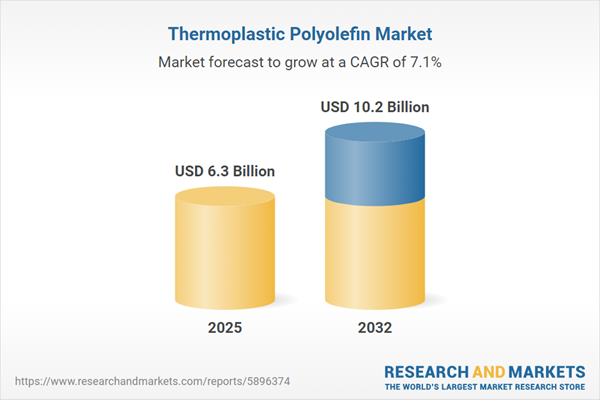Speak directly to the analyst to clarify any post sales queries you may have.
Thermoplastic polyolefin is reshaping how businesses address operational efficiency, resilience, and adaptability in dynamic industries. Senior leaders prioritizing performance and compliance increasingly view this versatile material as a strategic asset for streamlining production and maintaining competitive positioning.
Market Snapshot: Thermoplastic Polyolefin Market Size and Growth
The global thermoplastic polyolefin market is valued at USD 5.88 billion in 2024. Industry forecasts project growth to USD 6.30 billion in 2025 and surpassing USD 10.20 billion by 2032, at a compound annual growth rate of 7.12%. This sustained upward trajectory is driven by ongoing investments in material integration, increasingly stringent regulatory frameworks, and continuous advancements in production efficiency. Automotive, construction, and electronics sectors remain primary influencers of material demand and innovation, while expanding activity in developing economies generates new avenues for business development. Executives are monitoring regulatory trends, integrating risk management, and optimizing sourcing strategies to enhance supply chain resilience.
Scope & Segmentation of the Thermoplastic Polyolefin Market
A detailed segmentation strategy enables companies to align investment and production plans with changing market needs. Strategic focus on product applications, technological developments, material variants, and distribution methods ensures robust supply chain operations and compliance readiness.
- Application Areas: Utilized extensively across automotive manufacturing, roofing and building materials, consumer goods, and electrical components, with an emphasis on improving durability, user safety, and meeting regulatory benchmarks.
- Product Types: Ranges include homopolymers, impact copolymers, random copolymers, and terpolymers, supporting a variety of manufacturing processes and specifications.
- Form Variants: Availability in films, granules, pellets, powders, and sheets provides flexibility for manufacturers and allows tailored production workflows.
- Production Processes: Technologies such as blow molding, extrusion, and injection molding support material customization for evolving technical and market requirements.
- Distribution Channels: Options span direct sales, authorized distributors, and digital platforms, offering timely delivery for both standardized and specialized orders.
- Geographical Regions: The market covers the Americas, Europe, Middle East, Africa, and Asia-Pacific. Asia-Pacific gains advantages from integrated supply networks and infrastructure, while the Americas adapt to varying regulatory climates.
- Leading Companies: Major participants include Exxon Mobil Corporation, LyondellBasell Industries N.V., Dow Inc., Borealis AG, Solvay S.A., Saudi Basic Industries Corporation, Mitsui Chemicals, Inc., SK Global Chemical Co., Ltd., Westlake Chemical Corporation, and Formosa Plastics Corporation.
Key Takeaways: Strategic Insights for Senior Decision-Makers
- Thermoplastic polyolefin enables flexible and reliable product design, supporting evolving requirements across automotive, industrial, and infrastructure projects.
- Efforts toward sustainable sourcing, including adoption of recycled and bio-based materials, respond effectively to increasing legislative scrutiny and elevate environmental stewardship.
- Process innovations—such as simulation tools and additive manufacturing—enhance responsiveness to technical changes and unique client specifications, improving time-to-market.
- Regional customization of deployment strategies allows companies to match product offerings with local infrastructure and compliance standards, facilitating broader participation.
- Close collaboration within the supply chain, especially between OEMs and material suppliers, enables rapid adaptation to industry-specific disruptions and fosters operational consistency.
- Investment in advanced compounding technologies supports risk reduction and stability during periods of market fluctuation.
Tariff Impact: Navigating Trade Policy Disruptions
Recent changes in U.S. tariff policies have led organizations to reassess sourcing and logistic operations. Senior executives are addressing these disruptions by realigning supply chains, streamlining inventory strategies, and deploying advanced logistics planning tools to ensure customer expectations are met under shifting external pressures.
Methodology & Data Sources
This report draws from executive interviews, comprehensive analysis of industry standards, and targeted regulatory reviews. This integrated approach delivers actionable insights for operational improvements and investment validation.
Why This Report Matters to Senior Business Leaders
- Clarifies central drivers behind thermoplastic polyolefin adoption, providing essential context for risk management and streamlining operational performance.
- Enables leaders to anticipate and prepare for regulatory and technology transitions, strengthen supplier partnerships, and implement responsible sourcing frameworks.
- Supports cross-functional teams with informed guidance for procurement, material optimization, and bolstering network resilience to sustain long-term value.
Conclusion
This report offers senior executives the strategic foundation required to address regulatory changes, operational challenges, and future opportunities emerging across the thermoplastic polyolefin market.
Additional Product Information:
- Purchase of this report includes 1 year online access with quarterly updates.
- This report can be updated on request. Please contact our Customer Experience team using the Ask a Question widget on our website.
Table of Contents
3. Executive Summary
4. Market Overview
7. Cumulative Impact of Artificial Intelligence 2025
Companies Mentioned
The companies profiled in this Thermoplastic Polyolefin market report include:- Exxon Mobil Corporation
- LyondellBasell Industries N.V.
- Dow Inc.
- Borealis AG
- Solvay S.A.
- Saudi Basic Industries Corporation
- Mitsui Chemicals, Inc.
- SK Global Chemical Co., Ltd.
- Westlake Chemical Corporation
- Formosa Plastics Corporation
Table Information
| Report Attribute | Details |
|---|---|
| No. of Pages | 189 |
| Published | November 2025 |
| Forecast Period | 2025 - 2032 |
| Estimated Market Value ( USD | $ 6.3 Billion |
| Forecasted Market Value ( USD | $ 10.2 Billion |
| Compound Annual Growth Rate | 7.1% |
| Regions Covered | Global |
| No. of Companies Mentioned | 11 |









